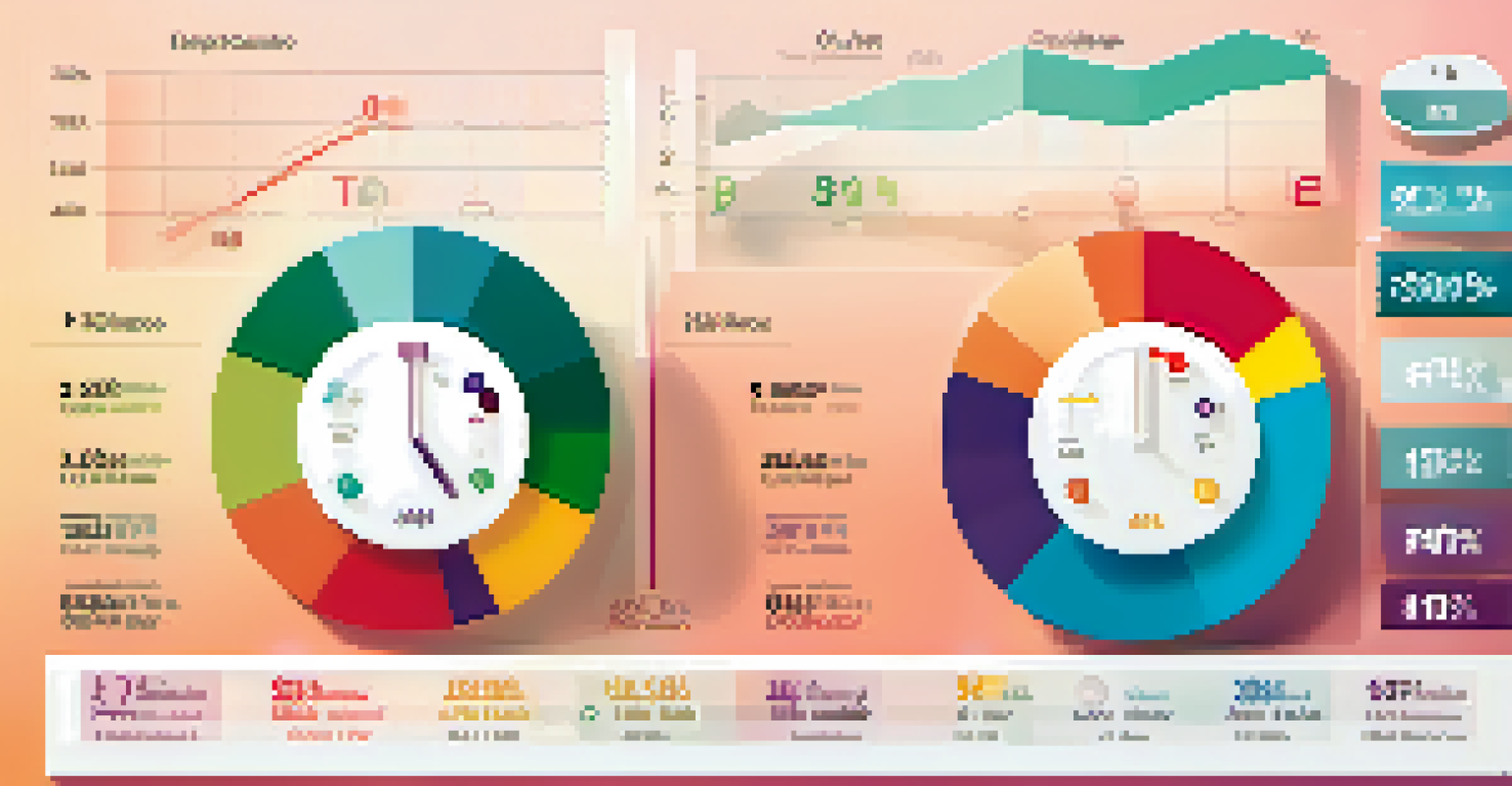Key Financial Ratios: Tools for Investment Analysis

What Are Financial Ratios and Why They Matter
Financial ratios are numerical values derived from a company's financial statements, providing insights into its performance. They help investors evaluate a company's profitability, liquidity, and overall financial health. By comparing these ratios against industry standards or historical data, investors can make informed decisions about buying, holding, or selling stocks.
In investing, what is comfortable is rarely profitable.
These ratios simplify complex financial data into digestible insights, making it easier for investors to spot trends and potential red flags. For instance, if a company's debt-to-equity ratio is significantly higher than its peers, it may indicate financial risk. Understanding these ratios empowers investors to act with confidence in their investment choices.
Ultimately, financial ratios are like a compass for investors, guiding them through the often turbulent waters of the stock market. Just as you wouldn't sail without a map, making investment decisions without analyzing these ratios could lead to poor outcomes. So, let’s dive into some key ratios that every investor should know.
The Price-to-Earnings (P/E) Ratio Explained
The Price-to-Earnings (P/E) ratio is one of the most popular metrics used to evaluate a company's stock price relative to its earnings. It is calculated by dividing the current share price by the earnings per share (EPS). A high P/E ratio may suggest that a stock is overvalued, while a low P/E could indicate that it is undervalued, but this is not always the case.

For example, a tech company might have a high P/E ratio due to expected future growth, while a utility company might have a lower P/E because of its stable but slower growth. Thus, it's essential to compare P/E ratios within the same industry for a clearer perspective. Context is everything when interpreting this ratio.
Financial Ratios Simplify Analysis
Financial ratios condense complex data, enabling investors to evaluate a company's performance and make informed decisions.
Investors should also consider the historical P/E ratio of the company to gauge how the current valuation measures up. If a company's P/E is significantly higher than its historical average, it might be time to question whether the growth prospects justify that valuation. Always remember, a number alone doesn’t tell the whole story.
Understanding the Debt-to-Equity (D/E) Ratio
The Debt-to-Equity (D/E) ratio measures a company's financial leverage by comparing its total liabilities to its shareholders' equity. A high D/E ratio indicates that a company relies more on borrowed funds than its equity, which can be risky during economic downturns. Conversely, a lower D/E ratio suggests a more conservative approach to financing.
The stock market is filled with individuals who know the price of everything, but the value of nothing.
For instance, a startup in growth mode may have a high D/E ratio as it invests heavily in expansion. On the other hand, a well-established company with steady cash flow may maintain a lower D/E ratio to ensure financial stability. Investors should analyze the D/E ratio alongside industry norms to assess whether a company’s leverage is reasonable.
It's essential to remember that not all industries are created equal; capital-intensive sectors, like utilities and telecommunications, typically have higher D/E ratios. Understanding the context behind the ratio helps in making better investment decisions. Always look beyond the numbers to see the bigger financial picture.
Exploring the Current Ratio for Liquidity Analysis
The Current Ratio is a liquidity measure that assesses a company’s ability to pay short-term obligations with its short-term assets. It is calculated by dividing current assets by current liabilities. A ratio above 1 indicates that the company has more assets than liabilities, which is generally a good sign.
However, too high of a Current Ratio might signal that the company is not efficiently using its assets to generate revenue. For example, if a company holds excessive inventory or cash, it could indicate missed growth opportunities. Therefore, while a healthy Current Ratio is essential, understanding its implications is equally important.
Context is Key for Ratios
Understanding the context and industry standards behind financial ratios is crucial for accurate interpretation and investment strategies.
Investors should also compare the Current Ratio to industry standards, as different sectors may have varying norms. A retail company, for instance, might have a lower Current Ratio compared to a tech firm due to different operational models. This comparison aids in determining whether a company is managing its liquidity effectively.
The Return on Equity (ROE) Ratio: A Measure of Profitability
Return on Equity (ROE) measures how effectively a company uses shareholders' equity to generate profits. It's calculated by dividing net income by shareholder equity. A higher ROE indicates a more efficient company that is making good use of its equity base to produce earnings.
For instance, if a company has an ROE of 15%, it means it generates $0.15 in profit for every dollar of shareholders' equity. Investors often look for companies with consistently high ROE figures, as they typically signify strong management performance and sustainable growth potential. However, it’s also important to consider the industry average, as some sectors naturally have higher ROEs than others.
Moreover, while a high ROE is appealing, it’s essential to analyze how it’s achieved. Companies can inflate their ROE through excessive leverage, which could be risky. Therefore, a thorough understanding of the factors driving ROE can provide deeper insights into a company's financial health.
The Importance of the Price-to-Book (P/B) Ratio
The Price-to-Book (P/B) ratio compares a company's market value to its book value, calculated by dividing the stock price by the book value per share. A P/B ratio under 1 can indicate that a stock is undervalued, while a ratio above 1 might suggest overvaluation. However, context is crucial in interpreting these figures.
For example, a financial institution like a bank might have a P/B ratio below 1 due to the nature of its assets. In contrast, a tech company with significant intangible assets may exhibit a higher P/B ratio, reflecting its growth potential. Thus, understanding the industry context is key when evaluating the P/B ratio.
Combine Ratios for Better Insights
Using multiple financial ratios together provides a comprehensive view of a company's health, enhancing investment decision-making.
Investors should also consider the company's growth prospects and historical P/B ratios to make informed decisions. A rising P/B ratio over time may indicate increasing investor confidence, while a declining P/B could signal trouble. Ultimately, this ratio is another tool in the investor's toolkit for assessing value.
Using Ratios Together for Comprehensive Analysis
While each financial ratio provides valuable insights, using them in conjunction can yield a comprehensive view of a company's financial health. For example, a high P/E ratio may not be concerning if the company also boasts a strong ROE and manageable D/E ratio. This multi-faceted approach to analysis helps investors make balanced decisions.
Additionally, combining ratios can help identify trends over time. If a company's current ratio decreases while its ROE increases, it may indicate a strategic shift that could impact future profitability. Understanding how different ratios relate to one another can enhance investment strategies and lead to more informed choices.

Moreover, it’s essential to remember that no single ratio should be the sole basis for investment decisions. Always consider the broader economic context, industry benchmarks, and company-specific news. By weaving together the insights from various financial ratios, investors can navigate the complexities of investment analysis with greater confidence.
Conclusion: Empowering Your Investment Decisions
In conclusion, financial ratios are invaluable tools for investors looking to make informed decisions. By understanding and analyzing key ratios like P/E, D/E, Current Ratio, ROE, and P/B, you can gain deeper insights into a company's financial performance. Each ratio tells a part of the story, and together, they create a more robust narrative about a company's potential.
Remember to consider industry context and historical performance when evaluating these ratios. Just as a map can guide you on a journey, these ratios can illuminate the path to sound investment choices. The more you understand, the better equipped you are to navigate the stock market.
Ultimately, the goal is to empower your investment decisions with knowledge and clarity. So, take the time to explore these financial ratios, and watch as they enhance your investment journey, helping you sail smoothly toward your financial goals.